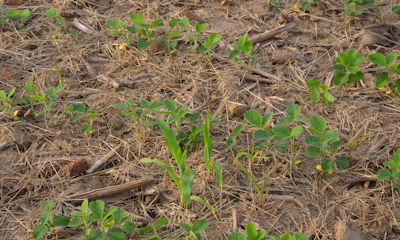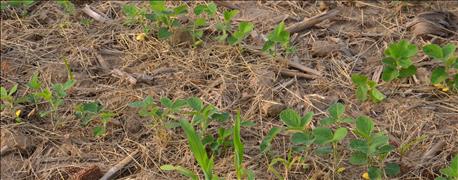
A son says he’s cutting soybean seeding rates to 140,000 seeds per acre. His father says ‘not on my fields!’ They plant with a split-row planter in 15-inch rows. Their normal planting rate is 165,000 seeds per acre.
Who is right? Is there a right answer? Should they apply seed treatments if they cut rates? If so, what kind of seed treatments? Does it matter how much risk they are willing to take?
Here’s a conversation put together from comments from three Indiana Certified Crop Advisers. They include Jesse Grogan, LG Seeds, Lafayette; Greg Kneubuhler, G & K Concepts, Harlan and Tom Stein, manager of Boswell/Templeton branches for Ceres Solutions.

THICK ENOUGH? This stand appears to be more than adequate. A hula-hoop and stand counts could confirm it. You would need to make sure it’s even, and spray for volunteer corn.
Stein: A final uniform stand of 100,000 plants per acre at harvest is sufficient for maximum soybean yields in most scenarios. It certainly is possible to achieve higher yields with higher harvest populations, but the incremental increase in yield over and above 100,000 plants per acre is relatively insignificant.
Kneubuhler: Our seeding rate trials have continually demonstrated that lower seeding rates as low as 125,000 seeds per acre, planted, will yield as much as 165,000 seeds per acre, planted. However, I would be slow to give a blanket recommendation without knowing exact locations, soil types and more. But in most cases, soybeans can be planted much more conservatively than 165,000 seeds per acre.
Stein: To achieve a final harvest population of 100,000 plants per acre, you need to take into consideration germination rate, percent of pure seed in the bag, and percent live seed that will emerge. For example, if the germ is 90%, there is 98% pure live seed in the bag and you expect 90% live seed emergence, multiply those factors together. The math is: 0.9 times 0.98 times 0.90 equals 0.79. Divide your desired harvest population by 0.79. If 100,000 is the desired plant population, your seeding rate would be 126,582 seeds per acre.
Kneubuhler: There’s an insurance factor that needs to be incorporated as Tom notes. Factors behind those numbers include soil type variation, planting date, whether the seed is treated and Mother Nature. As long as a stand is even across a field, a 100,000 final stand can yield at expected potential.
Grogan: It’s best to use fungicide-treated seed for planting in April and early May. Early planting with fungicide-treated seed results in better yields, and also results in less replanting due to poor stands. Cost of fungicide treatment just about equals cost saving from a reduced seeding rate. Seeding rate could be cut back to 140,000 seeds per acre. Lower seeding rate without fungicide protection could save 11 to 15% on costs, but increase risk of poorer stands and reduced yield.
Stein: Let’s look at seed costs if you reduce rates. Suppose the average seed size is 2,800 seeds per pound. Cost per 50-pound unit is $60. Seed cost translates to $0.43 per 1,000 seeds. If you reduce seeding rate from 165,000 to 126,582 as I noted earlier, it’s 38,418 fewer seeds per acre. At $0.43 per 1,000 seeds, you save $16.52 per acre.
About the Author(s)
You May Also Like




